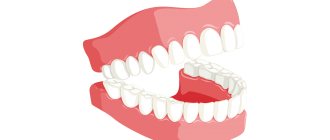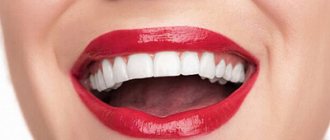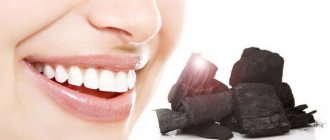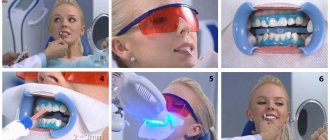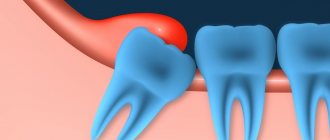Symptoms Causes Degrees of mobility Diagnostics Treatment methods Splinting Treatment at home Prevention
Normally, healthy teeth have little mobility due to the elasticity of the ligamentous apparatus and the need to absorb the chewing load. Physiological mobility is 0.06 - 0.15 mm, completely invisible to humans. Excessive mobility, noticeable when pressing on the tooth, is an anomaly that requires the intervention of a dentist. Even if a mobile tooth looks normal and does not hurt, loosening indicates a violation of the dentogingival connection, which is fraught with loss of a dental unit.
Pathological tooth mobility occurs due to various dental problems or injuries. What to do if a tooth is loose? Go to the dentist. Timely diagnosis and treatment will preserve the integrity of the dentition, restoring the functioning of the ligamentous apparatus. The treatment method is selected according to the severity of the defect, its location, and the presence of associated factors. After a comprehensive diagnosis, specialists from the RUTT clinic in Moscow will select treatment taking into account the clinical picture and indications for one or another method.
Symptoms
The main symptom is one - when you press on a tooth, it moves left and right or back and forth. Associated symptoms depend on the cause of mobility and may include:
- bad breath;
- redness, bleeding, swelling, soreness of the gums;
- abundant dental plaque;
- itching, burning gums;
- the tooth is loose and hurts when pressed;
- gum recession (exposure of the neck of the tooth);
- pathological abrasion of enamel;
- muscle hypertonicity;
- symptoms of intoxication - headache, fever, nausea, etc.
All causes are accompanied by corresponding symptoms - the tooth became loose after a characteristic crunch was heard, most likely we are talking about a longitudinal or scaly fracture of the root. A healthy tooth is loose - more often than not, this indicates an occlusal, mechanical injury. Several teeth in a row loosen at once - this is a manifestation of periodontal pathologies (periodontal disease, periodontitis).
Causes of tooth mobility
The roots of the teeth are located in the sockets (alveoli), they are firmly connected by the periodontium - a layer of connective tissue, collagen fibers, nerves and blood vessels. It is the periodontium that provides the necessary shock absorption of the dentition, allowing units to move in different planes, dampening chewing pressure. Periodontium is part of the periodontal tissues, such as gums, ligaments, cement, and bone surrounding the roots. If the connections between the alveolus, periodontium and tooth root are disrupted, the dental units begin to move beyond normal limits. The reasons for these changes are:
- inflammation and destructive changes in the periodontium (periodontitis, periodontal disease, periodontitis);
- dental diseases (flux, cyst, etc.);
- chronic systemic diseases (osteoporosis, diabetes mellitus, thyroid dysfunction and other diseases accompanied by metabolic, circulatory, and tissue regeneration disorders);
- malocclusion, uneven pressure on one tooth or group of elements (occlusal trauma);
- bruxism;
- jaw injury (bruise, fracture);
- prosthetics errors (incorrectly installed prostheses, implants);
- damage from solid food;
- large interdental spaces (teeth begin to shift towards the empty space);
- age-related changes (puberty, menopause, pregnancy and lactation, old age);
- bad habits;
- long-term use of certain medications.
Natural mobility associated with age occurs exclusively in children, when baby teeth are replaced by permanent teeth. If a molar tooth in an adult is loose, we are talking about pathology. The cause may be improper redistribution of chewing loads, disease, and not necessarily dental disease. Increased mobility may occur during orthodontic treatment. To eliminate it and stabilize the correction result, after removing braces or aligners, retention devices (retainers) are used.
Gum massage
Regular gum massage will help improve blood flow in the jaw and avoid the development of inflammation in the future. You can do massage yourself, even if you are far from medicine.
- First, wash your hands thoroughly.
- Then move your thumb and index finger along the gums: using circular movements, you need to massage the gums from the central part to the sides.
- Massage your gums for 5 minutes.
- Repeat the procedure morning and evening.
It is recommended to end each massage session with a herbal rinse, for example, a decoction of chamomile or oak bark.
Degrees of mobility
- I
– the tooth deviates back and forth from neighboring units
by no more than 1 mm
, there are no symptoms from the periodontium or gums; - II
– amplitude of swing back and forth and sideways
by 1 mm or more
, tartar and plaques are visible on the enamel, redness, swelling, bleeding and soreness of the gums are possible; - III
– the teeth swing strongly in any direction with slight pressure with the tongue or chewing, the amplitude of the displacements
significantly exceeds 1 mm
; - IV
– the tooth shifts in all planes, rotates around its axis, and
barely stays
in the gum tissue.
Pathological mobility of any degree requires complex treatment. If the tooth is located in the gum, the periodontium and socket are intact, the process is reversible. Dental units begin to become very loose when periodontitis or periodontal disease is advanced. With deep periodontal damage, weakening and destruction of the ligamentous apparatus, bone atrophy, tooth extraction may be required, followed by implantation and prosthetics.
Consumer Reviews
yuliya1305 (otzovik.com):
“Hello dear friends and readers of the site. Today I want to share with you a review about the Vitamin and Mineral Complex Coral Calcium Asepta
These vitamins contain:
- Coral calcium;
- Coenzyme G10$
- Vitamin C;
- Vitamin D3;
- Vitamins B3, B6;
- Vitamin A;
- Green tea extract.
These vitamins come in 721 mg tablets.
To prevent my gums from bleeding, I also use other drugs from this company. I have already written my reviews about them... By the way, these vitamins are contraindicated for pregnant women.
Well, I’ll tell you honestly, I’m very pleased with these drugs and recommend them to everyone. Because Vertex lives up to expectations!\3
Svettik19 (otzovik.com):
"Hi all!
A little background. Having had a sore throat, which I successfully cured myself at home without taking antibiotics, I was glad that everything worked out. But that was not the case.
Two weeks later, I realized that something was wrong with my gums. An unpleasant sensation appeared in the mouth. I noticed that my gums became more sensitive. Pain occurred when brushing teeth. I was very afraid that periodontitis would develop.
I immediately purchased several gum rinses, as well as the Asept vitamin and mineral complex, a domestic manufacturer. The course of administration is designed for 40 days, 1 tablet per day.
I felt an improvement after 2 weeks of regularly taking vitamins, and also lightly massaged my gums with tea tree essential oil.
At the moment I have completed the course and can already give a real review. The composition of the complex is very successful and is aimed specifically at strengthening the gums and maintaining healthy teeth.
Its composition is excellent:
coral calcium, coenzyme, vitamin C, vitamin D3, vitamins B3, B6, vitamin A. And also green tea extract.
All these components are in reasonable dosage. Can be taken without fear. The tablet itself is oval in shape and is very easy to swallow.
It took me a while to find this complex; I had to go around several pharmacies in the city and ordered a pharmacy online.
I can confidently recommend it, I liked how they work. I think they can also be taken as a preventative measure.”
Diagnostics
Diagnosis begins with collecting anamnesis. The dentist finds out when the tooth began to become very loose, whether this happened before, and what chronic diseases the patient has. Next, a dental examination of the oral cavity is carried out, the general condition of the dentition and periodontium is assessed. The degree of unsteadiness is assessed according to the subjective sensations of the patient and the dentist. The doctor checks the direction and magnitude of the deviation using tweezers:
- the instrument is applied to the upper part of the dental crown and moved in different directions;
- to identify vertical or circular displacement, the crown is clamped, carefully lifted up, and rotated.
Additionally, X-ray diagnostics are performed: orthopantomogram, CT scan, targeted X-ray to identify periodontal pathologies, injuries, and assess the depth of tissue damage. Based on the results obtained, effective treatment is selected. If mobility is due to a chronic disease, a specialized specialist (endocrinologist, therapist, rheumatologist, etc.) is involved in treatment. Why the lower teeth are loose, what is causing the mobility of the upper incisor - the doctor will be able to accurately answer these questions after a comprehensive dental examination.
Stock
-17%
Quadrotti dentures (without palate) 60,000 rub.
50,000 rub.
get -27 %
Teeth in 1 day on Straumann implants using ProArch technology!
300,000 rub. 220,000 rub.
get -13 %
Metal-free dental crown made of zirconium dioxide 40,000 rub.
35,000 rub.
get -50 %
Treatment of stomatitis for the promotion of 10,000 rubles.
5000 rub. get
Treatment methods
The treatment regimen and the scope of medical manipulations are selected according to the patient’s somatic status. The inflammatory process is eliminated, professional oral hygiene is performed, and antimicrobial therapy is prescribed. Treatment of mobility is aimed at eliminating the underlying cause that led to the weakening of the ligamentous apparatus. If it is periodontal disease, then infection and inflammation are treated; in case of malocclusion, orthodontic treatment is carried out; in case of injury, a temporary splint is applied.
Treatment includes various methods, including grinding crowns, normalizing occlusion, splinting, and prosthetics.
- Thanks to bite correction, the load on the periodontium is normalized, the teeth occupy a more stable position in the sockets.
- Wearing a special mouthguard that prevents clenching or grinding of the teeth will help strengthen loose teeth in the gums during bruxism or clenching.
- In case of physiological changes, hormonal levels and nutrition are corrected, vitamin therapy is carried out, and the immune system is strengthened.
- In case of injury, a special device is installed on the dentition - a splint, which helps to fix loose units and correctly distribute the load between healthy and injured teeth.
In some cases, it is impossible to save a loose tooth. Direct indication for extraction
is mobility of 3-4 degrees with loss of bone tissue by 70%, atrophy of the jaw bone by more than 50% with damage to the dental pulp. In such situations, it is advisable to remove the loose tooth, preserving the bone tissue for subsequent implantation.
How to cope with pain?
Toothache is always a good reason to see a doctor; it’s worth taking the time to avoid complications!
If professional dental care is not possible, first aid is to relieve pain and minimize inflammation.
Analgesics of various effects used in dentistry - tempalgin, ketorol, nurofen; standard dosage regimen - 1-2 tablets every 4 hours; The effect of the drugs begins within the first 15 minutes and lasts up to 6 hours.
Splinting teeth
The method is aimed at strengthening the teeth in the gums and preventing their further loosening. The essence of the manipulation is to combine mobile units into one block with healthy ones using a special fixing structure. Splinting can be temporary ( up to 1-3 months
), long-term (
up to 1 year
), permanent. Tires are divided into:
- removable
– mouthguards, clasp dentures; - non-removable
- tape, fiberglass or aramid thread, crowns, pin inlays (intradental splints), cap splints.
An effective option is fiberglass splinting
, aesthetic nanomaterials or ceramics. A strong, translucent white tape or thread is fixed to the inner surface of the teeth using a light-curing composite. The material is biocompatible with the human body, does not absorb saliva, does not enter into chemical reactions, firmly adheres to the enamel, and reliably holds the units in the desired position.
With temporary splinting, the structure is fixed for several months. This option is used for mild forms of periodontitis, periodontitis, to consolidate the result of orthodontic correction or mobility caused by injury. A permanent splint is installed in the treatment of moderate periodontitis, the presence of voids in the row (removed or fallen units). The fixing structure is replaced with a new one every 4-5 years
, sometimes more often (according to indications).
Splinting clasp prosthesis
Clasp prosthesis
– metal base (arch) with plastic gum and artificial crowns. Since the design has an attachment for each dental unit, the prosthesis can replace several lost teeth while simultaneously splinting loose elements. This method is used in the treatment of pathologies of moderate severity, when in addition to movable units there are healthy ones that serve as support for the prosthesis.
Splinting with crowns
The teeth are depulped, the root canals are filled, ground, and crowns made of durable material (metal-ceramics, ceramics, etc.) “soldered” to each other are fixed on them. This method is characterized by high reliability and long service life. The elements under the crowns are firmly locked together and completely motionless.
Comments
I recently had a tooth removed, after a while I noticed that the neighboring ones have now begun to wobble and seem to be moving, what should I do?
Mikhail (09/02/2019 at 10:52 am) Reply to comment
- Dear Mikhail! You need to contact your dentist as soon as possible and consider one of the possible options for prosthetics or implantation of an extracted tooth. When a tooth is removed, but there is no rush to restore it, the neighboring units are left without support and support, they begin to shift to the place of the lost tooth, and due to the fact that they have a double load, they can collapse and become loose. You need to not miss the moment when the teeth move significantly, because this will lead to difficulties in implantation and prosthetics of the missing unit, because the distance between them will not be enough to install a crown.
Editorial staff of the portal UltraSmile.ru (09/08/2019 at 09:19) Reply to comment
I have periodontitis, everything is exactly as you write, I was treated for a long time, now the disease seems to have subsided. Recently, several teeth were removed against this background, but most have been preserved for now. I wore a temporary partial removable denture, but it is uncomfortable, I want to install a fixed bridge, will it be more comfortable for me?
Oksana (10/06/2019 at 12:44 pm) Reply to comment
- Dear Oksana! You have periodontitis, which means the teeth remaining in your mouth are weakened and mobile, but the bridge must use those located on the sides of the lost ones as support. Accordingly, these already weakened teeth will be subject to a very strong load, one might even say that they will be overloaded. As a result, the structure will begin to wobble along with the supporting teeth, causing you pain and discomfort, which, of course, should not be allowed. It is not advisable to install a bridge, because most likely in 1-2 years it will fall out along with the supporting teeth - the probability of this is very high, because up to 30-40% of such cases are registered in clinical practice every year.
Editorial staff of the portal UltraSmile.ru (10/12/2019 at 08:59) Reply to comment
Write your comment Cancel reply
Adjuvant therapy
The main treatment involves auxiliary therapy aimed at preventing further loosening of the teeth. It includes:
- prescription of anti-inflammatory drugs, vitamins, biostimulants;
- ointments, gels to strengthen gums;
- antibiotic therapy;
- systematic professional teeth cleaning;
- physiotherapy (electrophoresis, plasma lifting, etc.);
- gum massage
If the front tooth becomes loose after an impact or several lower units become mobile due to bleeding gums, treatment should begin as quickly as possible. Complex therapy in the early stages around the moving element will help to form healthy tissue, ensuring reliable retention of the tooth in the gum. In complex, advanced cases, with 4 degrees of mobility, removal followed by prosthetics is advisable.
The gums are inflamed and swollen
If the gums are not very swollen, brushing your teeth with a hard brush may be the cause. But if your gums are swollen and inflamed significantly, you need to go to the dentist. Most likely, the matter is due to the inflammatory process and infection of the gum or tooth tissue. When the gums near the tooth are swollen and painful, this is characteristic of gumboil - inflammation of the periosteum. This is a dangerous disease that can lead to widespread infection.
Swollen and bleeding gums can be a sign of gingivitis, an infectious inflammation. It can then affect deeper tissues and cause a serious disease called periodontitis. In this case, patients complain that their gums are swollen and their teeth are loose.
One of the most dangerous diseases is a dental cyst. A benign neoplasm forms in the root area, it gradually increases in size, causing pain and swelling of the gums.
In any case, make an appointment with your dentist as soon as possible to avoid making the situation worse.
Prevention
To prevent tooth mobility, you must maintain careful oral hygiene and use brushes and pastes recommended by your doctor. Don’t forget to floss, irrigate, and rinse your mouth after eating. Regular visits to the dentist (every 6 months) for a preventive examination and professional cleaning will help identify pathology at the initial stage, avoid complications, and maintain a healthy smile.
Author of the article Voznyuk Vladimir Aleksandrovich Maxillofacial surgeon-implantologist of the highest category
Work experience: 28 years.
Periodontitis
Sometimes painful sensations occur in a tooth from which the nerve has already been removed. When pressed, the tooth hurts and aches. Many patients are perplexed as to how a fully treated organ can produce such symptoms. However, treatment is not always of high quality. The following mistakes may be made during canal filling:
- perforation of root canal tissues with an endodontic tip;
- incomplete cleansing of nerve tissue from the canal;
- poor quality disinfection of treated canals;
- insufficient tightness of canal sealing;
- the use of cheap fillings that can dry out over time.
All of the above reasons lead to various complications in the dental cavity. Of course, this does not happen immediately after treatment: it may take a month, and sometimes several years. However, such therapy will sooner or later make itself felt. The causing tooth will begin to ache at night, and then will react with pain to any pressure. The essence of periodontitis is the penetration of infection into the tissues of the dentoligamentous apparatus. Through the tip of the root canal, pathogenic bacteria enter the periodontium. There they slowly spread, forming cysts and granulomas of various types. Treating this type of inflammation is quite difficult and takes a long time, and a large percentage of such diseases require removal of the neglected organ.
When the first symptoms of periodontitis appear, dentists recommend following the following tips:
- If a tooth hurts when biting, it is strictly forbidden to apply heat to the sore spot;
- take one or two tablets of painkillers such as paracetamol, tempalgin, analgin;
- brush your teeth, removing food debris from the carious cavity of the affected tooth;
- rinse your mouth several times a day with a solution of potassium permanganate, soda or furatsilin;
- Do not take anti-inflammatory drugs or antibiotics without a doctor’s prescription.
In order to prevent unpleasant consequences for the health of the body, treatment of periodontitis should not be postponed and hope that the disease will disappear over time. A timely visit to the dentist will preserve not only the health of the tooth, but also the entire body, since periodontitis contributes to the emergence and spread of harmful substances. Of course, toxins will negatively affect the functioning of internal organs and a person’s well-being.
The LeaderStom network of clinics specializes in dental therapy, orthodontics and prosthetics. Our specialists try to cure even the most advanced cases of chronic pulpitis and periodontitis with maximum preservation of natural dental tissues. Treatment tactics depend on the degree of neglect. In the initial stages, the disease can be eliminated by refilling the canals. By eliminating the source of infection, dentists achieve stable remission of the tooth and restoration of periodontal tissue. If the inflammation process has covered a large area of tissue, and a purulent process has already formed near the apex of the root, then in this case either surgical intervention or removal of the diseased tooth is possible.



